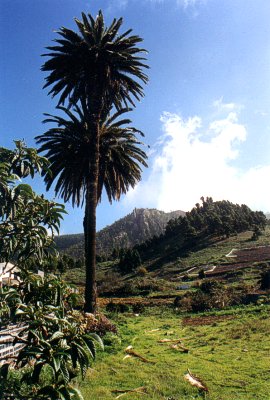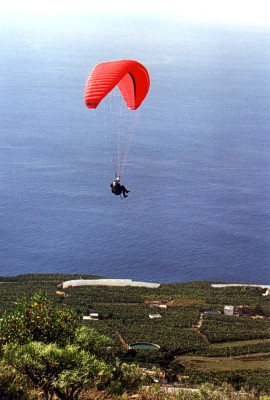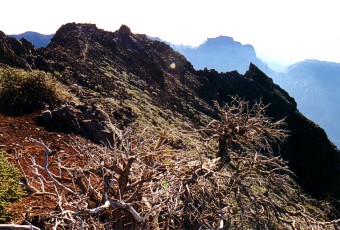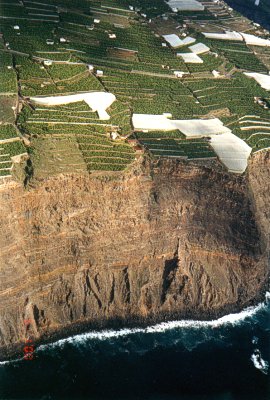|
A colorful parachute hovered over the surface of the ocean pulled along by a motorboat, by the Los Cristianos port on the island of Tenerife, though judging by the parachute's angle of inclination it was rather pushing air than flying. Local fishermen sat unmoving on large rocks by the water's edge and watched their bobbing floats. A flock of seagulls circled over the cliff and a warm ocean breeze murmered among the crouds of large palm trees on the shore. I took in this whole scene in a sort of blur only, as my thoughts were elsewhere entirely ...
"SHIP! I see a Ship!" tore me out of my reverie as Milan exclaimed, and truly... A white speck had appeared in the distance on the ocean, which gradually grew bigger until surging into port came a nine-storey tower block. A huge mouth across two floors opened on the bow and along with about 50 other cars we drove into its bowels, while hundreds of foot passengers boarded the upper decks by high steps. The boat was unbelievably huge and had a capacity of 100 cars and 1200 passengers. On the remaining floors were seats and tables for the passengers, thick carpets, a bar, a restaurant, shops and even a movie theater. After about four hours of cruising and, for a creature of the dry land, a bit of unusual swaying, we landed in the Santa Cruz harbor on the island of La Palma. The monster spit us out, this time, for a change, via the not so dignified rear opening. After a fast drive upwards along the mountain serpentines, we successfully reached the sought after villages. It was now after midnight, we crawled into bed and slept like logs.
In the morning we couldn't believe our ears. We were wakened by a rooster's crow and that was a sure sign that we were in the mountain village of Fuencaliente (Los Canarios), at an altitude of about 700 meters above the surface of the Atlantic ocean, on the southernmost tip of the island of La Palma. A look out the window clearly proved this to be so. In contrast to our stay on Tenerife, which was still fresh in our memory, this was truly a balm for the soul.

The entire island of La Palma has only 80 thousand inhabitants and is beautifully small and easy to take in. Even someone with a seriously impaired sense of navigation would have difficulty getting lost here. There are two main roads on the island, one along the perimeter and the second across the middle. The most telling fact of the size of the island is maybe that the distance between the landing strip on the beach at Santa Cruz on the East shore and the landing strip on the beach at Puerto de Tazacorte on the opposite western shore of the island is barely 17km as the crow flies. And should a pilot decide to fly from the southernmost situated runway, Las Indas, along the southwestern shore all the way to the beach at Puerto de Tezacorte, a route of not quite 19km awaits him, and once he has arrived above the harbour, he can turn around and fly back in the opposite direction.

|
The island of La Palma remains, for the time being, apart from the general tourist influx to the Canary Islands. In contrast to the most of the other islands, tourists are truly few and the beaches are almost empty so that you can land on them even in the busy afternoon hours. You can swim in the nude and in mountains and deep forests you'll not meet a soul for hours on end.

Of course, we wondered how this is possible on such a beautiful island. We found out the reasons are several. The majority of the mass tourists come to the Canary Islands to go drinking happily in the evening, lie around in bed late in the morning, and then, as is required, bake in the sun on the beach which is 50, and for the sports-minded, 100 at most paces from the check-in counter of their hotel. This ideal of the modern civilized man the Island of La Palma doesn't fulfil in several points, thank God. Firstly, there are relatively few hotels on the island. The building of more hotels is prevented by the expansive banana plantations, whose production is subsidized by the European Union, and while these subsidies exist, plantation owners will not sell their properties. So tourists are accommodated in typical rental houses in the villages, whose capacity is not large. From these villages 600m high, the journey to the beach is along winding mountain roads, by irregular bus transport and about 10km. For the typical tourists this means an additional complication. He has to rent a car, because walking back uphill from the beach would doubtless cause him to sweat. Furthermore, the number of beaches on the island isn't numerous. They are only to be found along the southwest and southeast shore, and though the roads lead to most of them, the last phase must be managed on foot down steep trails.
It is obviously for these reasons that the island of La Palma doesn't satisfy the majority of typical tourists. So this island is rather visited by people who will gladly swim in a beautifully clean ocean, and maybe even lie on the warm sand of a deserted beach for an hour or so, but then take off for the mountains, forests, on a trip, a hike, a bike ride or best of all for the nearest runway. The only hope remains that the European Union doesn't waste all of its finances on the countries of eastern Europe who are feverishly preparing to join it, and that some funds will remain to subsidize the banana plantations on the island of La Palma.

Flying Terrains
Just like on Tenerife, Lanzarote and actually on all of the Canary Islands, on the island of La Palma the predominating wind direction is northeast to east. While the mountain ranges on the islands of Tenerife and Lanzarote are disadvantageously situated from southwest to northeast and the predominating rapid winds flow around these crests from both sides, the high volcanic mountain crest on La Palma, with its highest mountain Roque de los Muchachos, with its peak at a height of 2426 meters and running across the entire island from North to South, ideally divides the island into the mainly windward eastern side and the leeward western half.
|



